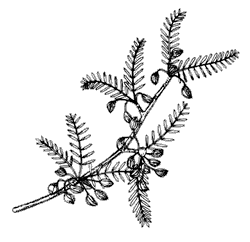Burseraceae (torchwood family)
The New World elephant trees are nearly unknown to the general public, but nearly everyone has heard of their Old World relatives. The aromatic sap of frankincense (Boswellia sacra) and myrrh (Commiphora spp.) was once worth its weight in gold. It’s still quite valuable, and most wild frankincense trees are sacred, hereditary property and are zealously protected. Our native species are also valuable to those who know them. The tropical species south of the desert are used in products as diverse as incense, masks, and asthma treatment.
The torchwood family contains 550 species of shrubs and trees worldwide, many of which have succulent stems and aromatic foliage. There are about 12 species of Bursera in the Sonoran Desert region, about a third of which occur in the desert.
Bursera microphylla
English name: elephant tree
Spanish names: torote blanco, copal,
palo colorado (red stick), torote
colorado
Description
This large shrub or small tree grows to 25 feet (8 m) tall; it usually has several contorted trunks and reddish branches. The trunks and main branches are swollen with water-storage tissue and covered with whitish sheets of thin, peeling bark. The thin bark transmits sunlight to chlorophyll-bearing tissue in the stems, which can thus conduct photosynthesis when the plant is leafless. The stems and the finely divided, shiny green leaves are highly aromatic. It may leaf out in any month in response to rain, but stem growth is mainly in summer. The flowers, which open around the time of the summer solstice (the hottest, driest time of the year, when almost nothing else is blooming), are tiny and inconspicuous.
 |
Range
This is a true desert species, occurring in western Sonora and almost all of Baja California with a few marginal populations in south-central Arizona (reaching northern limits in some Phoenix-area mountain parks) and extreme southern California. The plants in some Arizona populations look quite different from Mexican plants and may be hybrids or a new species.
Notes
While the aromatic sap of this and other burseras smells pleasant to humans, it tastes foul and functions as an herbivore deterrent. The sap is under pressure; when a leaf is broken, a thin stream of sap spurts out an inch (2.5 cm) or so. This “squirt-in-the-eye” defense is apparently effective, since the elephant tree’s foliage is nearly always intact.
The bitter fruit stimulates salivation and the Seri sometimes chew it to quench thirst. They used the soft wood to make boats. The sap is used to seal cracks in boats and pottery. The aromatic oils are used in a variety of medicines, including treatments for stingray wounds, lice, cuts, and gonorrhea.
The other desert species of Bursera, except for one in Baja California, are scarcely succulent and not easily confused with B. microphylla. But two unrelated plants look almost identical when not in leaf (which is most of the year). Pachycormus discolor (Baja elephant tree, torote blanco, copalquin) often grows side by side with B. microphylla in Baja California, but responds to rainfall in the winter, when burseras are not actively growing. Pachycormus is in the cashew family (Anacardiaceae). Jatropha cordata (sangregado, mata muchachos) grows next to burseras in Sonora. A member of the spurge family (Euphorbiaceae), J. cordata is more closely related to Poinsettia than to Bursera. These three look-alike species are prime examples of convergent evolution.